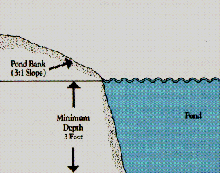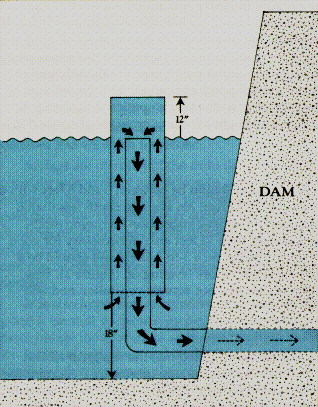 |
||||
Chapter 1: Site Planning and Pond Construction
Perhaps the most important aspect of pond management is deciding where and how to build your pond. Many problems can be avoided if the pond is properly designed and constructed. The Natural Resources Conservation Service (NRCS) publication "Ponds - Planning, Design, Construction" (Agriculture Handbook 590) contains detailed information on design surveys, site selection, drainage area, pond layouts, soil analysis and spillway construction. Contact your county NRCS office to obtain a copy. Your county NRCS staff can provide additional information on cost estimation and other aspects of pond construction, or refer you to a reputable engineer for assistance. To take advantage of these services, contact the NRCS during the initial stages of pond planning.
There are two general types of ponds:
Watershed or embankment ponds, which are formed by constructing a dam to collect stream or surface runoff,
Excavated ponds, which are formed by digging down into the water table in an area that is relatively flat.
The type of pond that is best for your site will be determined to a great extent by the topography of the land and the principal use of the pond.
It is usually necessary to move more earth to construct an excavated pond than a watershed (embankment) pond. Watershed ponds, however, are more likely to have problems with muddy water, high siltation rates, rapid fluctuations in flow rates, aquatic weeds, temperature fluctuations, and wild fish invasions. Large watershed ponds can benefit from construction of a small settling pond immediately upstream to reduce turbidity, sedimentation, and weed problems in the large pond.
Permits
After choosing a site, contact a representative of the U.S. Army Corps of Engineers to make sure that the site is not located in a wetland area, especially if the pond is to be of the watershed type. Streams are considered wetland areas. If pond construction involves placing a dam across a stream or affects a wetland in other ways, you are required by law to obtain a 404 permit from the Corps of Engineers before starting construction.
Additional permits may also be required for certain types of watershed ponds. If the dam height will exceed 15 feet and impounded water volume (at the dam crest) will exceed 10 acre-feet, or if the dam is deemed to be a high hazard structure that would cause significant property damage or loss of life upon failure, you are required to obtain two additional permits (one for construction and one for impoundment of water) from the North Carolina Department of Environment and Natural Resources (DENR) Dam Safety Program. The agency may also require that you prepare a sediment and erosion control plan to prevent excessive siltation if a stream is being impounded during construction. To ensure that your pond will conform to all state laws, contact the DENR Dam Safety Program (919-733-4574) or your nearest regional DENR office before beginning construction. Also check to see if local county or municipal ordinances require additional permits.
Drainage Area
An important factor in deciding where to build a pond is the nature of the surrounding watershed or drainage area. Generally, a watershed pond built in pastureland requires 5 to 20 acres of watershed per surface acre of pond, whereas a pond constructed in woodland requires 20 to 40 acres. If the drainage area is too large, it may be necessary to construct a diversion ditch to channel excess water around the pond. If the drainage area is insufficient, the pond will not fill adequately and will be subject to water-level fluctuations and vegetation problems.
Water Source and Quality
Potential water sources for a pond include surface runoff, streams, springs, and wells. Each source has advantages and disadvantages; the type chosen will depend to a large extent on where the pond is located. Surface runoff is rarely a source of disease or wild fish problems but leads to fluctuations in pond level during spring and fall. Streams are usually high in dissolved oxygen, but they also tend to fluctuate rapidly, are a source of silt, and are a potential source of diseases and wild fish invasions.
Springs are considered the most desirable water source because they have a constant temperature and flow rate, are very inexpensive to divert, are rarely a source of disease or wild fish problems, and are less likely to be affected by pollution. However, they may contain high concentrations of undesirable gases (hydrogen sulfide and carbon dioxide), and the high clarity of the water from most springs encourages vegetation problems. Wells offer good water quality and can be placed where convenient, but they are expensive to drill and operate.
It is also important to consider land uses within the watershed where the pond is located, as these may degrade the water quality. Runoff from cropland can increase the amount of sediment reaching the pond and may cause turbidity. It may also contain potentially toxic agricultural chemicals, as well as fertilizers that can cause algal blooms and resultant fish kills. Runoff from pastures and livestock holding areas is rich in nutrients (animal wastes) that can also cause algal blooms and fish kills. Residential, urban, and industrial runoff may contain substances (such as industrial waste, chemicals, oils, and sediment from construction activities) that can adversely affect a pond's water quality. When planning a pond, therefore, be sure to consider the quality of the water source and factors that may affect it.
Site Preparation
An important factor in deciding where to build a pond is the nature of the surrounding watershed or drainage area. Generally, a watershed pond built in pastureland requires 5 to 20 acres of watershed per surface acre of pond, whereas a pond constructed in woodland requires 20 to 40 acres. If the drainage area is too large, it may be necessary to construct a diversion ditch to channel excess water around the pond. If the drainage area is insufficient, the pond will not fill adequately and will be subject to water-level fluctuations and vegetation problems.
Size
The best fishing ponds have a surface area of at least 1 acre. Ponds of less than 1 acre are difficult to manage because the fish populations, especially largemouth bass, are easily overharvested. In addition, small, shallow ponds are susceptible to vegetation problems that usually result in overpopulation of sunfish. These problems ultimately result in stunted growth of both bass and sunfish. The fish populations in ponds of less than 1 acre are also adversely affected by drought. If you have a small pond and cannot afford to enlarge it, the best management tactic is to stock it with a single species of fish, such as channel catfish or hybrid sunfish, and begin a feeding program (discussed in a later section).
Depth
The average depth for a 1-acre or larger fish pond should be between 6 and 8 feet with a maximum depth not greater than 10 to 12 feet. An average depth less than 6 feet greatly increases the probability of aquatic vegetation becoming established in the pond. Depths greater than 12 feet are not necessary for good fish production, and are more likely to experience fish kills from summertime oxygen depletion. Pond banks should be cut on a 3-to-1 slope and should be a minimum of 3 feet deep at the waterline before leveling off (Figure 1). This shape will help prevent the growth of nuisance aquatic vegetation and will also discourage muskrats.

Water Control Structure
An important feature that should be incorporated into the design of all fish ponds greater than 1 acre is a water control structure (drainpipe). A drainpipe enables you to drain the pond to make repairs, fix leaks, and control nuisance aquatic vegetation. It also makes it possible to treat and remove undesirable fish species chemically and to manage the fish population more effectively. In addition, a drainpipe that incorporates a bottom drawoff device (Figure 2) ensures good water quality and reduces the chances of a fish kill by removing stagnant water from the bottom of the pond. Ponds tend to stratify in summer and winter, resulting in a stagnant bottom layer that is low in dissolved oxygen and may contain high concentrations of toxic gases (such as carbon dioxide, hydrogen sulfide, and ammonia).
Figure 2: Drainpipe incorporating a device for
drawing water from the bottom of the pond |
Another important feature that you should incorporate is an emergency spillway. This structure is designed to prevent loss of the dam during periods of extremely high water by rerouting excess water through a low spot over or around the dam. To meet individual requirements, it is best to ask your county NRCS office for advice about this aspect of pond design
Contacting the appropriate agency when first considering construction of a pond can prevent many costly mistakes.

